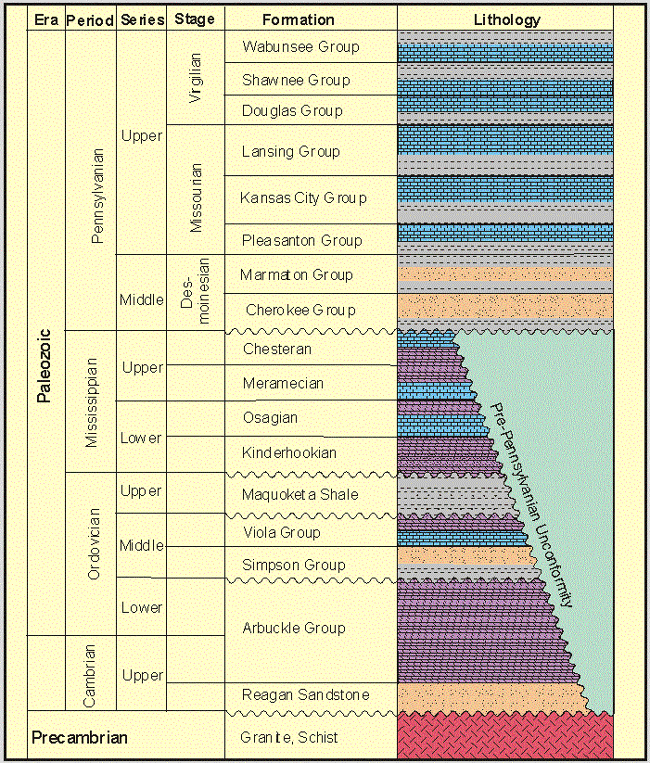
Kansas Geological Survey
Open-file Report 2001-55

|
|
Kansas Geological Survey Open-file Report 2001-55 |
Geologic BackgroundArbuckle rocks are a part of the craton-wide Sauk Sequence which is bounded, at its base and top by major major inter-regional unconformities (Sloss, 1963), The sea-level fall that marked the end of Arbuckle Group deposition resulted in subaerial exposure of platform carbonates. During the early Middle Ordovician, dissolution and karst development formeda regionally extensive karst system over most of the North American craton. This regional system has been labeled the Arbuckle-Ellenburger-Knox-Prarie du Chien-Beekmantown-St. George karst plain (Kerans, 1988). The Arbuckle and equivalent reservoirs in the Mid-continent are generally considered to have favorable reservoir qualitiesthat are directly related to rejuvenated basement structural elements resulting in fractures, regional uplifts, and minor horst and graben features. Reservior qualities were modified by karst processes during prolonged and repeated subaerial exposure that began after Arbuckle deposition and continued in some areas until the Pennsylvanian (Franseen, et al., 1995).The regional and stratigraphic extent of subaerial exposure and karstification in the Arbuckle was influenced by regionalpatterns of uplift and subsidence (Newell et al., 1987). Structure played a major role in the development of Arbuckle reservoirs on several different scales. On a regional scale, most hydrocarbon production within the Arbuckle in Kansasoccurs on two major structural uplifts. The two features that affect the Paleozoic rocks in Kansas are the northeast-southwest trending Nemaha uplift, and the group of structures trending northwest-southeast that include the Cambridge arch, the Central Kansas uplift, and the Pratt Anticline (Newell et al., 1989). Throughout most of the Paleozoic, until the Permian, the Central Kansas uplift was a shelf area sinking and receiving sediments, but with a thinner sedimentary cover than the more rapidly subsiding Salina basin on the northeast and the Hugoton embayment of the Anadarko basin on the southwest (Walters, 1958). Locally, Arbuckle strata were uplifted and extensively eroded during Late Mississippian-Early Pennsylvanian deformation. Especially affected was the Central Kansas uplift, where Middle Pennsylvanian strata directly overlie Arbuckle strata or where the Arbuckle has been completely removed (Franseen, 1994). |
|

|
| Stratigraphic column of Paleozoic strata in the study area showing the relationship to Sub-Pennsylvanian unconformity. |
|
|
e-mail : webadmin@kgs.ku.edu
Last updated January 2002
http://www.kgs.ku.edu/PRS/publication/OFR2001-55/P1-04.html